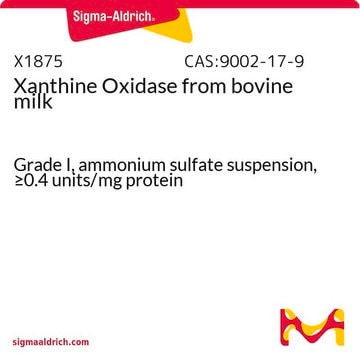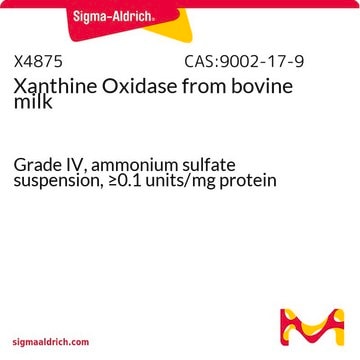682151
Xanthine Oxidase, Buttermilk
Native xanthine oxidase from buttermilk. Complex metalloprotein that catalyzes oxidative hydroxylation of a variety of aromatic heterocycles and simple aldehydes. Catalyzes the oxidation of xanthine to uric acid.
Synonym(s):
Xanthine Oxidase, Buttermilk
Sign Into View Organizational & Contract Pricing
All Photos(1)
About This Item
CAS Number:
MDL number:
UNSPSC Code:
12352202
NACRES:
NA.54
Recommended Products
Quality Level
form
liquid
specific activity
≥0.5 units/mg protein
manufacturer/tradename
Calbiochem®
storage condition
do not freeze
foreign activity
lactoperoxidase, none detected
shipped in
wet ice
storage temp.
2-8°C
General description
Native xanthine oxidase from buttermilk. Complex metalloprotein that catalyzes oxidative hydroxylation of a variety of aromatic heterocycles and simple aldehydes. Catalyzes the oxidation of xanthine to uric acid.
Native xanthine oxidase from buttermilk. Complex metalloprotein that catalyzes oxidative hydroxylation of a variety of aromatic heterocycles and simple aldehydes. Has an optimal pH of 4.6 and a pI of 5.3-5.4. Catalyzes the oxidation of xanthine to uric acid.
Packaging
Please refer to vial label for lot-specific concentration.
Warning
Toxicity: Standard Handling (A)
Unit Definition
One unit is defined as the amount of enzyme that will convert 1.0 µmol of xanthine to uric acid per min at 25°C, pH 7.5.
Physical form
Crystalline suspension in 60% ammonium sulfate.
Other Notes
McWhirter, R.B. and Hille, R. 1991. J. Biol. Chem.266, 23724.
Legal Information
CALBIOCHEM is a registered trademark of Merck KGaA, Darmstadt, Germany
Signal Word
Danger
Hazard Statements
Precautionary Statements
Hazard Classifications
Resp. Sens. 1
Storage Class Code
11 - Combustible Solids
WGK
WGK 3
Certificates of Analysis (COA)
Search for Certificates of Analysis (COA) by entering the products Lot/Batch Number. Lot and Batch Numbers can be found on a product’s label following the words ‘Lot’ or ‘Batch’.
Already Own This Product?
Find documentation for the products that you have recently purchased in the Document Library.
Customers Also Viewed
Articles
Hybrid organic-inorganic sol-gel materials containing silica were first called “ORMOSILs” in 1984.
Our team of scientists has experience in all areas of research including Life Science, Material Science, Chemical Synthesis, Chromatography, Analytical and many others.
Contact Technical Service

















